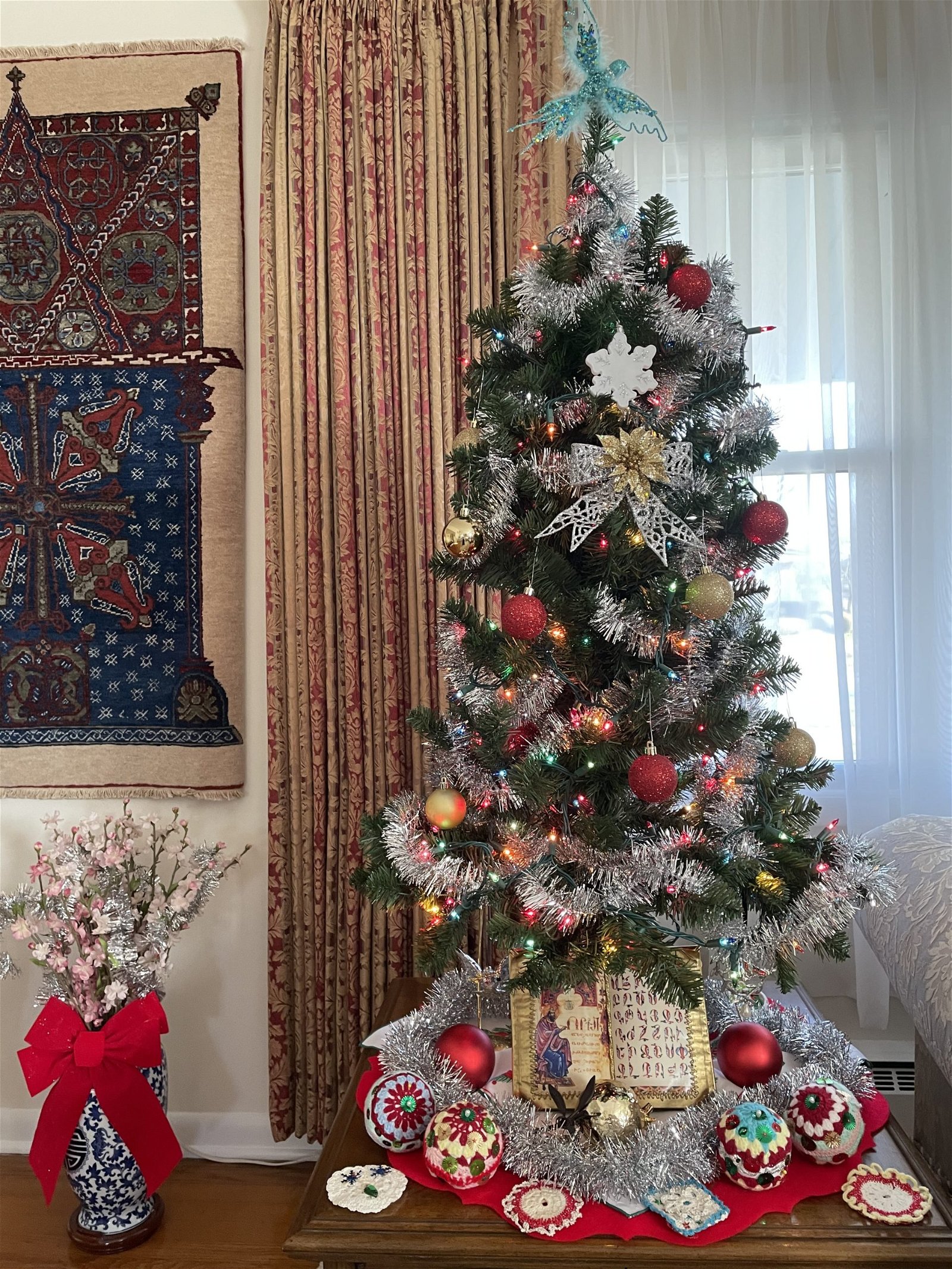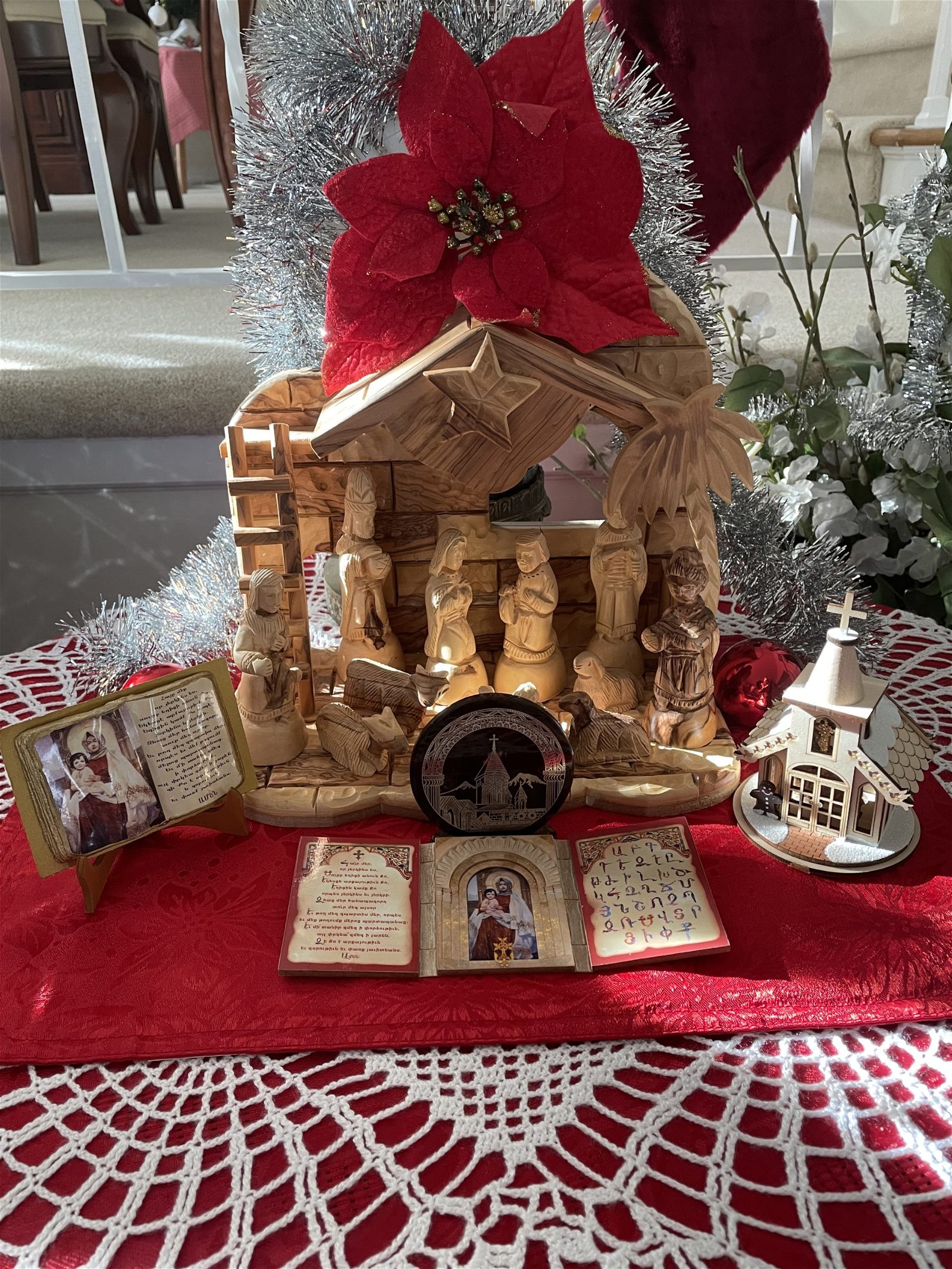There is a chill in the air, and the sky is gray as gusty winds scatter the last of the autumn leaves. Yesterday, snow flurries dusted the landscape, and the few remaining roses finally lost the last of their petals. Winter is near—a quiet and reflective time of the year. Soon, it will be Christmas followed by thoughts of the coming New Year.

The small Christmas tree, standing on an end-table in my living room, shimmers with silver garlands, ornaments, colorful lights and memories. On the opposite side of the room on another table is a wooden carving of the Nativity scene resting on needlework made in Syunik, Armenia—a place close to my heart because it was my father’s birthplace, and that of his father’s, grandfather’s, great-grandfather’s… Also, it was the birthplace of my relative, a young man in his early 20s, who lost his life last year in defense of Artsakh. As I look at the tree and then at the Nativity scene, I recall Christmas celebrations that took place in our home over the years. Those memories sparked memories of Christmas celebrations of an even earlier time—that of my childhood, and how they were spent with my parents, first in Europe’s displaced persons (DP) camps, and then in our final home in America.

In America, eventually, our family grew until we were five siblings. Our Christmas gifts were small and few; at times we’d share them, followed by a festive dinner. For the New Year’s table, we had meat, rice, vegetables, dolma (stuffed grape or cabbage leaves), sometimes also Khash (meaning boil in Armenian, and is a thick soup that takes many hours to prepare), my mother’s Viennese apple strudel and butter cookies, fresh and dried fruits and nuts. December 25 was the day we opened Christmas gifts, but January 6 was strictly a religious holiday when Armenians celebrate both the birth of Jesus and His baptism.
Though many Christmases have passed since those early years in Europe and later in America, the beauty and wonder of Christmas remain with me, especially when I recall my very first Christmas gift. I received it in the Austrian DP camp my parents and I called home until we were moved to France and then to another DP camp in Germany. Despite the severe deprivations, food rations and extremely harsh living conditions, my Armenian father (a teacher and writer), who was a POW and slave laborer in Europe, and my Austrian mother were able one Christmas to purchase a gift for me—an orange. Oh, how big, round, juicy and tasty it was! Then, on another Christmas, a few years later in the DP camp in Germany, I received a pair of red, high-top shoes. Those shoes never came off my feet until it was bedtime, then I’d put them under my pillow. After I had outgrown the shoes, I still kept them under my pillow until we left for America.
One Saturday morning during the Christmas season, when I was around nine years old, I accompanied my mother to the grocery store. The snow was deep, and from time to time, we’d step on patches of slippery, snow-covered ice. The wind was biting and strong as it pushed us forward every so often. Together, my mother and I pulled the silver-colored shopping cart down one long street after another and another. When we neared the grocery store, my mother and I noticed a man selling newspapers on the street corner. His shoes were so worn and tattered that they had holes in them. My mother said “Hallo” to him, and he responded with a smile. When we returned home from the store, my mother whispered something to my father, who was reading in the living room. He nodded and left the room. Within no time, he was back carrying his “Sunday-going-to-church-shoes” in one hand and with the other wiping them with his shoe rag. My mother carefully wrapped the shoes in newspaper. Before she left, with me at her side, she asked my father, “What will you wear to church now?”
“I will wear my everyday shoes,” he said. “With a little shoe polish and a good rubbing the shoes will look nice for church.” He wore those shoes every day to his factory job, several evenings a week as he’d push a cart up and down the streets selling hotdogs and around the house.
When my mother handed my father’s shoes to the man selling newspapers, he looked in disbelief at my mother and quickly removed his worn shoes and put on the “new” ones. He smiled a broad smile at us and said, “They fit! Thank you! Thank you for the Christmas present!”
Over the years, the Christmas gatherings and festivities in our home (that of my husband’s and mine)—the celebration of Christmas both on December 25 and January 6 as I did in my childhood—changed, like the seasons. Our children grew up, married, moved away and had families of their own. Now they continue the family traditions. One by one, grandparents and other relatives passed away. With each change in our lives and in our home, Christmas celebrations grew more quiet, less festive, though the meaning of Christmas always remained. Then one day, unexpectedly, in an instant, the most difficult change of all took place in our home of many years. In that instant, the house—the world—grew silent, sunless and cold. When Christmas neared that year, I recalled my late husband’s words spoken years earlier after I had tearfully announced to him, “I am in no mood to observe Christmas or to decorate a tree and the house this year,” after one of my parents had passed away.
My husband had slowly nodded, then had softly replied, “No, you must observe and celebrate Christmas always, no matter what. Christmas must never die!”
Though the Christmas tree that now adorns my home is no longer a tall or large one, like the ones of years past, it is a lovely one. And, on the table where it stands are some of my mother’s hand-made ornaments—some round, some flat, reminding me of the many Christmas trees we had over the years—first, the ones of my childhood when my mother, while singing “Silent Night” in German, would decorate the tree with lights, ornaments, tinsel and hard candy that she would wrap in white tissue paper, then twist the ends, carefully snip fringes on the two twisted ends, and hang them on the branches with white string. And later, our own tree that each year grew more abundant with an assortment of ornaments, including my mother’s hand-made ones, and the ornaments our children and grandchildren made at school.
The Christmas tree, the Donatsar, is a wondrous sight to behold, for “The evergreen tree is a fitting representation of the long-withstanding love of God, and the gift of His Son born unto us.”
In the Bible God compares himself to a tree: “I am like an evergreen cypress; from me comes your fruit.” – Hosea 14:8b
In the Armenian Christmas song, the Good News (Avedis), is proclaimed:
“Today is a celebration of the Holy Birth, Avedis…
The Revelation of our Lord, Avedis…”
May the beauty and wonder of Christmas be with us all, especially our fellow Armenians in Armenia, Artsakh and the Middle East.


This beautiful, sentimental, touching story brought tears to my eyes and a smile to my face. It should be shared with a non-Armenian audience, too.
Great reflections of the meaning and importance of Christmas celebrated through good and bad days in an Armenian family.
Very well written.
Thank You Knarik,
Moving and Inspiring -truly what Christmas is all about
Merry Christmas to you and your family
Oscar
Merry Christmas and a Happy New year to you all and in remembrance of your esteemed husband Murad.
;Kristos Tznav Yev Haydnetsav
Orhnial e haynoutium Kristosi
Dear Knarik,
This story brought tears to my eyes. I’m so glad that finally after two weeks of its publication, I got to read this inspiring and sentimental reflections. Thanks for sharing. All my best, to you and yours, for this coming year…
Lovely, sentimental, hopeful and well-written article to read and savor during this holiday season, and always. Let’s all keep such fond memories and hopes in our hearts.